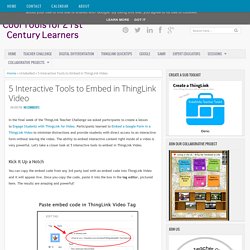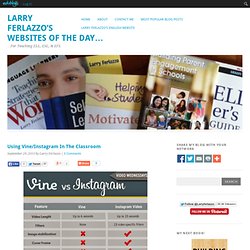

Mini-series lecture recording – Teaching Matters blog. Ways to use a screencast application in your teaching - Screencast-o-matic. I have been screencasting for many decades now.

A screencast is a video you take of your screen. Often screencasts include audio, at the bare minimum, but they have become even more full-featured in recent years. Criteria for Screencasting Applications When I try out a screencasting tool, the following are the criteria I use to evaluate the application: Easy to learn – It must be simple to get started screencasting using the tool. Basics of Filmmaking: The Shot - Kaltura Blog. A few years ago, Kaltura employee David Kronmiller put together some very entertaining videos on the basics of filmmaking and working with a camera.

And you know what? They’re still relevant! We’re running a series of these fun videos to show you some of the ways you can spice up your videos. Cory Doctorow: Information Doesn’t Want To Be Free. Editor’s note: Cory Doctorow is a science-fiction author, activist, journalist and blogger, as well as the co-editor of Boing Boing.

The former European director of the Electronic Frontier Foundation and co-founder of the U.K. Open Rights Group lives in London. This is an excerpt from the chapter “Worse Than Nothing” from his latest book “Information Doesn’t Want to Be Free” published this month by McSweeney’s. The technical implausibility and unintended consequences of digital locks are big problems for digital-lock makers. Video and Professional Development: The Power of Observation. TedEd. Créer des leçons en vidéo. Article mis à jour le 3 décembre 2015 par Fidel Navamuel TedEd est un outil en ligne qui permet de créer des leçons vidéo interactives et de les proposer à vos étudiants.
Très facile à utiliser, cette plateforme est liée à la fondation internationale qui propose les conférences TED (Technology, Entertainment and Design). Cette fondation a été créée pour diffuser des « idées qui valent la peine d’être diffusées » (en anglais : « ideas worth spreading »). L’éditeur de vidéos TedEd est gratuit et permet de partager n’importe quelle vidéo présente sur YouTube en la complétant avec des enrichissements interactifs. Après une rapide inscription sur le site, vous allez pouvoir créer votre première leçon en vidéo. Il suffit d’indiquer l’URL YouTube de la vidéo que vous souhaitez utiliser. Sous le lecteur de la vidéo, vous avez accès à quatre menus : Watch , Think, Dig Deeper, Discuss, …and finally Think. Dig Deeper. . … and finally est le lieu pour le mot de la fin. 5 Interactive Tools to Embed in ThingLink Video. In the final week of the ThingLink Teacher Challenge we asked participants to create a lesson to Engage Students with ThingLink for Video.

Video and Online Learning: Critical Reflections and Findings From the Field. Could Video Feedback Replace the Red Pen? Stills from a video critique by Monash U.’s Michael Henderson.

Writing useful comments on students’ work can be a fine art. And for instructors who put a lot of effort into crafting a critique, there’s always a substantial risk students will skip the written feedback and go right to the grade. When Michael Henderson is grading his students’ final assignments, he likes to skip the written comments for them. Instead of a red pen, Mr. Henderson, a senior lecturer in education at Monash University, in Australia, takes out a video camera. Mr. REC:all - Recording and Augmenting Lectures for Learning. Using Vine/Instagram In The Classroom. I do a lot of videotaping in my classes, primarily in IB Theory of Knowledge and in my ELL ones, and have been thinking about experimenting with Vine or Instragram’s stop motion clips.

Though I posted The Best Resources For Learning To Use The Video App “Vine,” I haven’t used it much other than to try it out with videos of my pets A new post by Amy Erin Borovoy over at Edutopia, however, has finally pushed me to give it a try in the classroom. Her post, Five-Minute Film Festival: Vine and Instagram Video in the Classroom, shares some great examples that are perfect models for students. I’m planning on having students in my IB Theory of Knowledge class use Vine or Instagram (at least in our high school, Instagram seems to be the app that many of the kids use) to illustrate the different Ways Of Knowing. How and why to use television to learn Chinese.
This is the first guest article by Luke Howard, whom I met on one of the Hacking Chinese meet-ups here in Taipei.

He speaks Chinese well and when he told me that he relies heavily on watching TV to learn the language, I naturally became interested and wanted to know more. I don’t watch much TV myself, so instead of writing about this myself, I asked Luke to write about it. Enjoy! Television is a valuable asset in the modern language learners toolkit. Best Practice Hints and Tips: Video in learning and teaching. Best Practice Hints and Tips: Video in learning and teaching by sarahhorrigan on May 8, 2014 At our recent East Midlands Learning Technologists’ meeting, ‘Video Killed the Radio Star’, we were exploring the digital video creativity and between us we came up with a list of hints and tips for those wanting to work with video in learning and teaching.

I promised I’d share our hints and tips… so… here they are… Preparation Don’t underestimate the time it takes. Theodora's blog. Basic Guide to Shooting Video. 9 Video Tips for a Better Flipped Classroom. Flipped Classroom | November 2013 Digital Edition 9 Video Tips for a Better Flipped Classroom Early adopters share how schools can find success with teachers and students alike--even when the technology seems as topsy-turvy as the lessons.

In 2007, when Colorado high school teachers Jonathan Bergmann and Aaron Sams began experimenting with recording their lectures in order to spend class time on deeper face-to-face learning with students, they probably didn't foresee the major movement that would grow up around what came to be called the flipped classroom. But six years later, the growth in interest remains exponential, suggesting this is far more than a fad. Just since January 2012, the number of active members on the Flipped Learning Network's Ning site has grown from 2,500 to more than 15,000. Today, it seems, there is no one correct way to flip the classroom, and approaches vary both by subject and educational philosophy. 1) Devise a flipped strategy. 2) Start small. Flick-It-On! Collaborative Movie Making Challenge. A new Flick-It-On!

Project is starting on the 14th October 2013! We are aiming for the project to go INTERNATIONAL this time round. We have just finished the last project. Vertical Video Syndrome - A PSA. One Hundred and One Things About Video In Education. The 20th annual conference of the Association for Learning Technology (altc2013) 10–12 September 2013, Nottingham, UK altc2013 Building new cultures of learning Everybody learns, but the ways in which we learn are changing rapidly. The 20th annual conference of the Association for Learning Technology (ALT) sets out to explore and contribute to building new cultures of learning. From learning tailored to the requirements of one individual to courses educating tens of thousands, the conference will examine evolving learning cultures. 101 Things about Video is a short presentation – 413 at altc2013, Thursday 12th September 2013.
Authors: Sandra Partington, Luis Balseca, Mike Hughes, Steven McCombe, Sophie Paluch, Morris Pamplin, Natasa Perovic, Connie Tse. Mrsebiology.sharedby.co/k91jh8. Five-Minute Film Festival: Copyright and Fair Use for Educators. I absolutely love it when teachers and students create, remix, and mash up media; it's a fantastic way to encourage deeper learning and media literacy. But one issue that complicates digital freedom of expression is copyright law. While many would argue that copyright law is outdated and badly in need of an overhaul, it's still critical that adults and kids alike have a basic understanding of what's legal and ethical while playing with other people's intellectual property. Here's a list of videos I collected to help you navigate the murky waters of copyright law in educational settings. Can you learn a language from watching foreign films? Blackboard blogs.